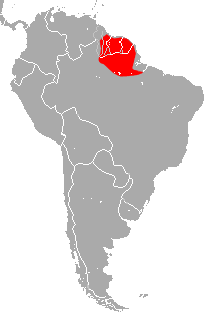Amazonian sac-winged bat: Difference between revisions
Tisquesusa (talk | contribs) No edit summary |
bolding |
||
| (18 intermediate revisions by 10 users not shown) | |||
| Line 1: | Line 1: | ||
{{Short description|Species of bat}} |
|||
| ⚫ | |||
{{speciesbox |
|||
| ⚫ | |||
| ⚫ | |||
| ⚫ | | status_ref = <ref name=iucn>{{cite |
||
| |
| status = DD |
||
| ⚫ | |||
| phylum = [[Chordata]] |
|||
| ⚫ | |||
| classis = [[Mammal]]ia |
|||
| |
| genus = Saccopteryx |
||
| ⚫ | |||
| familia = [[Emballonuridae]] |
|||
| ⚫ | |||
| genus = ''[[Saccopteryx]]'' |
|||
| ⚫ | |||
| binomial = ''Saccopteryx gymnura'' |
|||
| ⚫ | |||
| range_map = Amazonian Sac-winged Bat area.png |
| range_map = Amazonian Sac-winged Bat area.png |
||
| range_map_caption = Amazonian sac-winged bat range |
| range_map_caption = Amazonian sac-winged bat range |
||
}} |
}} |
||
The '''Amazonian sac-winged bat''' (''Saccopteryx gymnura'') is a [[bat]] |
The '''Amazonian sac-winged bat''' (''Saccopteryx gymnura'') is a [[bat]] species of the family [[Emballonuridae]]<ref name = "Simmons">{{MSW3 Chiroptera | id = 13801046 | page = 391}}</ref> native to South America.<ref name="iucn status 19 November 2021" /> |
||
==Taxonomy and etymology== |
|||
It was [[species description|described]] as a new species in 1901 by British zoologist [[Oldfield Thomas]].<ref name="Thomas 1901">{{cite journal| last=Thomas| first=O.| year=1901| title=New species of ''Saccopteryx'', ''Sciurus'', ''Rhipidomys'', and ''Tatu'' from South America| journal=The Annals and Magazine of Natural History; Zoology, Botany, and Geology| series=7| volume=7| issue=39|pages=367–368| url=https://biodiversitylibrary.org/page/26195909}}</ref> Thomas identified "Mr. Wickham" as the collector of the [[holotype]], possibly referring to British explorer [[Henry Wickham (explorer)|Henry Wickham]] who also collected bird specimens in South America.<ref name="Sclater 1867">{{cite journal| last1=Sclater| first1= P. L.| last2= Salvin| first2= O. |name-list-style=amp | year=1867| title= List of birds collected on the Blewfields River, Mosquito Coast, by Mr. Henry Wickham| journal=Proceedings of the Zoological Society of London | volume=1867 |pages=278–280 | url=https://books.google.com/books?id=-O8KAAAAIAAJ&q=henry%20wickham%20collected&pg=PA278}}</ref> Wickham collected the holotype in [[Santarém, Pará|Santarém]] along the [[Amazon River]].<ref name="Thomas 1901"/> The [[specific epithet (zoology)|species name]] "''gymnura''" is from [[Ancient Greek]] "''[[wiktionary:γυμνός|gumnós]]''" meaning "naked" and "''[[wiktionary:οὐρά|ourá]]''" meaning "tail." Thomas wrote, "the nakedness of the [[interfemoral membrane|interfemoral [membrane]]] will readily distinguish this bat from any of its allies."<ref name="Thomas 1901"/> |
|||
==Biology and ecology== |
|||
It is [[insectivore|insectivorous]], catching its prey in the air<ref name="iucn status 19 November 2021" /> and inhabits [[tropical rainforest]]s. It is found in several countries and territories in northern [[South America]], including [[Brazil]], [[French Guiana]], [[Guyana]], and [[Suriname]].<ref name="iucn status 19 November 2021" /> It is uncommonly encountered and its range is not clearly defined. |
|||
It is currently evaluated as [[data deficient]] by the [[IUCN]].<ref name="iucn status 19 November 2021" /> |
|||
==References== |
==References== |
||
| Line 24: | Line 29: | ||
{{DEFAULTSORT:Amazonian Sac-Winged Bat}} |
{{DEFAULTSORT:Amazonian Sac-Winged Bat}} |
||
[[Category: |
[[Category:Saccopteryx]] |
||
[[Category:Bats of South America]] |
[[Category:Bats of South America]] |
||
[[Category: |
[[Category:Bats of Brazil]] |
||
[[Category:Mammals of French Guiana]] |
[[Category:Mammals of French Guiana]] |
||
[[Category:Mammals of Guyana]] |
[[Category:Mammals of Guyana]] |
||
[[Category:Mammals of Suriname]] |
[[Category:Mammals of Suriname]] |
||
[[Category:Fauna of the Amazon]] |
|||
[[Category:Mammals described in 1901]] |
[[Category:Mammals described in 1901]] |
||
[[Category:Taxa named by Oldfield Thomas]] |
[[Category:Taxa named by Oldfield Thomas]] |
||
{{Bat-stub}} |
|||
Latest revision as of 15:52, 20 November 2022
| Amazonian sac-winged bat | |
|---|---|
| Scientific classification | |
| Domain: | Eukaryota |
| Kingdom: | Animalia |
| Phylum: | Chordata |
| Class: | Mammalia |
| Order: | Chiroptera |
| Family: | Emballonuridae |
| Genus: | Saccopteryx |
| Species: | S. gymnura
|
| Binomial name | |
| Saccopteryx gymnura | |

| |
| Amazonian sac-winged bat range | |
The Amazonian sac-winged bat (Saccopteryx gymnura) is a bat species of the family Emballonuridae[3] native to South America.[1]
Taxonomy and etymology[edit]
It was described as a new species in 1901 by British zoologist Oldfield Thomas.[2] Thomas identified "Mr. Wickham" as the collector of the holotype, possibly referring to British explorer Henry Wickham who also collected bird specimens in South America.[4] Wickham collected the holotype in Santarém along the Amazon River.[2] The species name "gymnura" is from Ancient Greek "gumnós" meaning "naked" and "ourá" meaning "tail." Thomas wrote, "the nakedness of the interfemoral [membrane] will readily distinguish this bat from any of its allies."[2]
Biology and ecology[edit]
It is insectivorous, catching its prey in the air[1] and inhabits tropical rainforests. It is found in several countries and territories in northern South America, including Brazil, French Guiana, Guyana, and Suriname.[1] It is uncommonly encountered and its range is not clearly defined.
It is currently evaluated as data deficient by the IUCN.[1]
References[edit]
- ^ a b c d e Sampaio, E.; Lim, B.; Peters, S. (2016). "Saccopteryx gymnura". IUCN Red List of Threatened Species. 2016: e.T19806A22005356. doi:10.2305/IUCN.UK.2016-2.RLTS.T19806A22005356.en. Retrieved 19 November 2021.
- ^ a b c d Thomas, O. (1901). "New species of Saccopteryx, Sciurus, Rhipidomys, and Tatu from South America". The Annals and Magazine of Natural History; Zoology, Botany, and Geology. 7. 7 (39): 367–368.
- ^ Simmons, N.B. (2005). "Order Chiroptera". In Wilson, D.E.; Reeder, D.M (eds.). Mammal Species of the World: A Taxonomic and Geographic Reference (3rd ed.). Johns Hopkins University Press. p. 391. ISBN 978-0-8018-8221-0. OCLC 62265494.
- ^ Sclater, P. L. & Salvin, O. (1867). "List of birds collected on the Blewfields River, Mosquito Coast, by Mr. Henry Wickham". Proceedings of the Zoological Society of London. 1867: 278–280.

